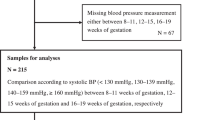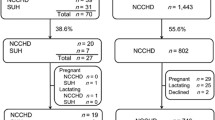Abstract
Little research has been conducted into the long-term effects of preeclampsia, despite its frequent occurrence. The aim of this review is to examine the association between preeclampsia and the development of hypertension and kidney diseases later in life. To achieve this aim, we evaluated three retrospective studies conducted in our department. In the first study, 52 women who suffered from preeclampsia during their first pregnancy were followed for 2 years after delivery for any long-term effects upon blood pressure. In the second study, we evaluated HOMA-R, pulse wave velocity and augmentation index in groups of 48 postmenopausal women with a past history of preeclampsia and 204 postmenopausal women without a past history of preeclampsia. In the third study, we examined the association between a past history of preeclampsia and chronic kidney disease based on biopsy in 127 postmenopausal women. From the first study, although there were no significant differences in age, blood pressure at the onset of preeclampsia, the levels of proteinuria and the birth weight of the child between women who remained hypertensive and those who became normotensive, body mass index was significantly larger in women who remained hypertensive compared to those who were normotensive. In the second study, we found that women with a past history of preeclampsia exhibited insulin resistance combined with reduced vascular elasticity. In the third study, of 32 patients with a past history of preeclampsia, 12 patients exhibited focal segmental glomerulosclerosis, 10 exhibited IgA nephropathy and 10 exhibited nephrosclerosis. In contrast, of the women without a past history of preeclampsia, 26 patients exhibited IgA nephropathy, 20 exhibited a minimal change in nephritic syndrome, 6 exhibited nephrosclerosis, 6 exhibited membranous nephropathy, 5 exhibited lupus nephritis, 5 exhibited diabetic nephropathy, and 27 exhibited various nephropathies. None of the women without a past history of preeclampsia exhibited focal segmental glomerulosclerosis. Taken together with previous results, these findings suggest that hypertension and chronic kidney disease in postmenopausal women are closely associated with a past history of preeclampsia.

Similar content being viewed by others

References
Suzuki H, Saruta T. An overview of blood pressure regulation associated with the kidney. Contrib Nephrol. 2004;143:1–15.
Sattar N, Greer IA. Pregnancy complications and maternal cardiovascular risk: opportunities for intervention and screening? BMJ. 2002;325(7356):157–60.
Pell JP, Smith GCS, Walsh D. Pregnancy complications and subsequent maternal cerebrovascular events: a retrospective cohort study of 119,668 births. Am J Epidemiol. 2004;159(4):336–42.
Ray JG, Vermeulen MJ, Schull MJ, Redelmeier DA. Cardiovascular health after maternal placental syndromes (CHAMPS): population-based retrospective cohort study. Lancet. 2005;366(9499):1797–803.
Noris M, Perico N, Remuzzi G. Mechanisms of disease: pre-clampsia. Nat Clin Pract Nephrol. 2005;1:98–114.
Irgens HU, Reisater L, Irgens LM, Lie RT, Roberts JM. Long term mortality of mothers and fathers after pre-eclampsia: population based cohort study pre-eclampsia and cardiovascular disease later in life: who is at risk? BMJ. 2001;323(7323):1213–7.
Wilson BJ, Watson MS, Prescott GJ, et al. Hypertensive diseases of pregnancy and risk of hypertension and stroke in later life: results from cohort study. BMJ. 2003;326(7394):845–9.
Vikse BE, Irgens LM, Bostad L, Iversen BM. Adverse perinatal outcome and later kidney biopsy in the mother. J Am Soc Nephrol. 2006;17(3):837–45.
Gibson GB, Platt R. Incidence of hypertension after pregnancy toxaemia. Br Med J. 1959;2(5145):159–62.
Adams EM, Macgillivray I. Long-term effect of preeclampsia on blood-pressure. Lancet. 1961;2:1373–5.
Chesley LC, Annitto JE, Cosgrove RA. The remote prognosis of eclamptic women, sixth periodic report. Am J Obstet Gynecol. 1976;124:446–59.
Kotchen JM, McKean HE, Kotchen TA. Blood pressure of young mothers and their children after hypertension in adolescent pregnancy: six-to nine-year follow-up. Am J Epidemiol. 1982;115(6):861–7.
Sibai BM, el-Nazer A, Gonzalez-Ruiz A. Severe preeclampsia-eclampsia in young primigravid women: subsequent pregnancy outcome and remote prognosis. Am J Obstet Gynecol. 1986;155(5):1011–6.
Lindeberg S, Axelsson O, Jorner U, Malmberg L, Sandström B. Prospective controlled 5-year follow up study of primiparas with gestational hypertension. Acta Obstet Gynecol Scand. 1998;67:605–7.
Fisher KA, Luger A, Spargo BH, Lindheimer MD. Hypertension in pregnancy: clinical–pathological correlations and remote prognosis. Medicine. 1981;60:267–76.
Laivuori H, Tikkanen M, Ylikorkala O. Hyperinsulinemia 17 years after preeclamptic first pregnancy. J Clin Endocrinol Metab. 1996;81(8):2908–11.
Smith GC, Pell JP, Walsh D. Pregnancy complications and maternal risk of ischaemic heart disease: a retrospective cohort study of 129,290 births. Lancet. 2001;357(9273):2002–6.
Smith GD, Whitley E, Gissler M, Hemminki E. Birth dimensions of offspring, premature birth, and the mortality of mothers. Lancet. 2000;356(9247):2066–7.
Suzuki H, Kobayashi K, Kanno Y, Nakamaoto H, Okada H. Pulse wave velocity discriminates white coat hypertension in postmenopausal hypertension. In: 19th scientific meeting of the international society of hypertension. 2002. p.6.
Roberts JM, Gammill HS. Preeclampsia: recent insights. Hypertension. 2005;46(6):1243–9.
Chambers JC, Fusi L, Malik IS, Haskard DO, De Swiet M, Kooner JS. Association of maternal endothelial dysfunction with preeclampsia. JAMA. 2001;285(12):1607–12.
Reckelhoff JF, Fortepiani LA. Novel mechanisms responsible for postmenopausal hypertension. Hypertension. 2004;43(5):918–23.
Jonsdottir LS, Arngrimsson R, Geirsson RT, Sigvaldason H, Sigfusson N. Death rates from ischemic heart disease in womne with a history of hypertension in pregnancy. Acta Obstet Gynecol Scand. 1995;74:772–6.
Chambliss KL, Shaul PW. Estrogen modulation of endothelial nitric oxide synthase. Endocr Rev. 2002;23(5):665–86.
Chesley L, Annitto JE, Cosgrove RA. The remote prognosis of eclamptic women. Sixth periodic report. Am J Obstet Gynecol. 1975;124:446–59.
Hannaford P, Ferry S, Hirsch S. Cardiovascular sequeles of toxaemia of pregnancy. Heart. 1997;77:154–8.
Hubel CA, Sanaedal S, Ness RB, et al. Dyslipoproteinaemia in postmenopaausal women with a history of eclampsia. Br J Obstet Gyanecol. 2000;107:776–84.
Suzuki H, Watanabe Y, Arima H, Inoue T, Kanno Y, Okada H. Close association between pre-eclampsia and chronic kidney diseases in middle-aged women. In: 39th annual meeting of American society of nephrology. 2006; San Diego.
Heaton JM, Turner DR. Persistent renal damage following pre-eclampsia: a renal biopsy study of 13 patients. J Pathol. 1985;147:121–6.
Gaber LW, Spargo BH. Pregnancy-induced nephropathy: the significance of focal segmental glomerulosclerosis. Am J Kidney Dis. 1987;9(4):317–23.
Abe S. Pregnancy in IgA nephropathy. Kidney Int. 1991;40(6):1098–102.
Kaaja R, Tikkanen MJ, Viinikka L, Ylikorkala O. Serum lipoproteins, insulin, and urinary prostanoid metabolites in normal and hypertensive pregnant women. Obstet Gynecol. 1995;85(3):353–6.
McFarlane SI, Banerji M, Sowers JR. Insulin resistance and cardiovascular disease. J Clin Endocrinol Metab. 2001;86(2):713–8.
Tylicki L, Rutkowski B, Horl WH. Multifactorial determination of hypertensive nephroangiosclerosis. Kidney Blood Press Res. 2002;25(6):341–53.
Sarafidis PA, Ruilope LM. Insulin resistance, hyperinsulinemia, and renal injury: mechanisms and implications. Am J Nephrol. 2006;26(3):232–44.
Acknowledgments
We appreciate greatly the kind referral of subjects for this study by Professors H. Takeda, H. Seki, K. Baba, and their colleagues in the General Medical Center for Perinatal Mother-Children, Saitama General Medical Center Hospital.
Author information
Authors and Affiliations
Corresponding author
Appendix
Appendix
All work was performed according to the Declaration of Helsinki; approval was granted by the institutional ethics committee, and all patients gave written, informed consent.
Definitions of words
Menopause was defined as the absence of a period for 1 year.
Preeclampsia was defined as having maximum blood pressure of at least 140 mmHg systolic and 90 mmHg diastolic accompanied by proteinuria of >0.3 g/24 h prior to labor.
The kidney biopsy diagnosis of glomerular disease was made in accordance with the criteria described in the World Health Organization’s monographs on kidney disease. Consequently, kidney diseases were classified into the following five categories: (1) mesangial proliferative, (2) other immune complex GN (including membranous GN, endocapillary GN, or GN associated with SLE), (3) focal and segmental glomerulosclerosis or minimal GN, (4) other pathological findings at kidney biopsy, acute or chronic interstitial nephritis, benign nephrosclerosis, diabetic nephropathy, vaculitis, thrombotic microangiopathy, crerscentic GN, or other rare kidney disease, and (5) normal findings at kidney biopsy or unrepresentative biopsy specimen.
Statistical analysis
Results were expressed as mean ± SEM. Statistical analysis was performed using the Student’s t test for unpaired samples (or Mann–Whitney tests when applicable for comparison of means. P less than 0.05 was regarded as significant.
About this article
Cite this article
Suzuki, H., Watanabe, Y., Arima, H. et al. Short- and long-term prognosis of blood pressure and kidney disease in women with a past history of preeclampsia. Clin Exp Nephrol 12, 102–109 (2008). https://doi.org/10.1007/s10157-007-0018-1
Received:
Accepted:
Published:
Issue Date:
DOI: https://doi.org/10.1007/s10157-007-0018-1



